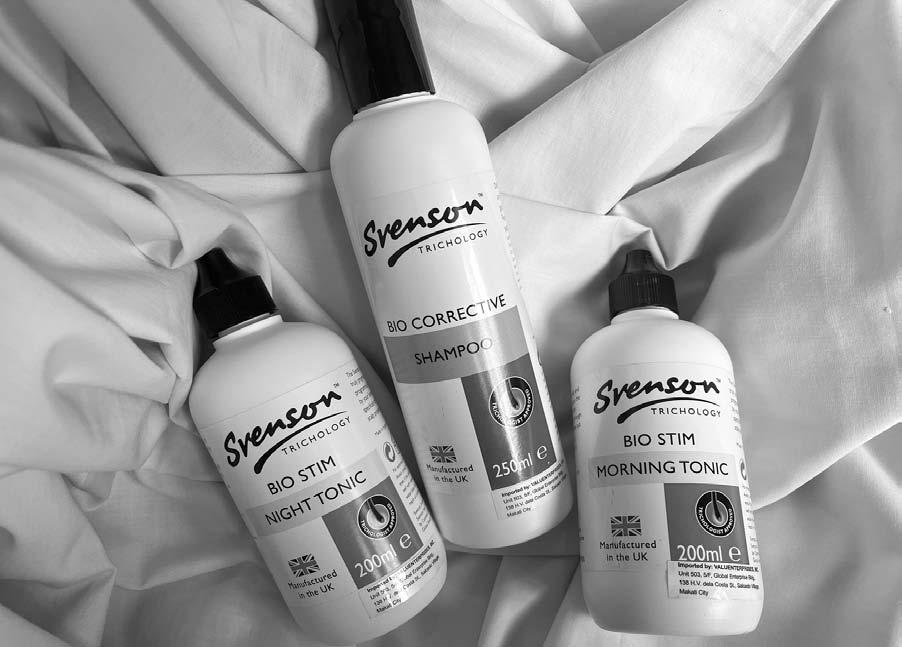
3 minute read
The difference between dandruff and dermatitis, what you can do about them
other hand, is characterized by a scalp that often looks red or has red spots. This manifests as large, oily and yellowish scales on the scalp.
The dermatologists I saw all said the flare-ups were usually caused by stressed and the dyes in the hair color I used. When you have atopic dermatitis, you don’t always have dandruff and itching. That happens when you have flare-ups. So what else, aside from stress, can trigger these flare-ups? The triggers can include heavy fragrances, cigarette smoke, heat styling, even sweat.
DURING the pandemic, many people suffered from excessive hair loss and/or dandruff. These subjects used to be taboo but today, people are more open about struggling with these conditions.
In the past, there was some shame in talking about hair loss and dandruff, with the latter having an ick factor (note: dandruff is not contagious). But things have changed. There is no shame in going through these conditions. They’re normal and so many people have them. In fact, I cannot count the times that I was asked by strangers on the internet what to do when they have excessive hair loss and/or scalp problems. I always say the first step is to see a board-certified dermatologist. For this column, I will talk about the one condition that has hounded me for over a year, and that is dandruff. It took a while before a dermatologist assessed my scalp condition as atopic dermatitis, a chronic form of dermatitis that can appear on the scalp but also affects other parts of the body such as the ears, eyebrows, and the forehead. The condition is itchy, uncomfortable and sometimes embarrassing. So how do you know the difference between dandruff and atopic dermatitis?
Dandruff appears as white flakes of dead skin in your hair or on your shoulder. It is caused by cold and dry weather, and some hair products such as shampoo and conditioner. Atopic dermatitis, on the
If you have severe flare-ups, a doctor may prescribe a steroid, such as hyydrocortisone 1 percent cream, a more potent cream or ointment, bandages and wet wraps phototherapy (ultraviolet light treatment to reduce inflammation), oral corticosteroids and, sometimes, antibiotics to prevent skin from becoming infected when you scratch, and antihistamines to reduce severe itching.
As for shampoos, look for those with salicylic acid, coal tar, selenium sulfide, and zinc pyrithione. One of the best I have used is Neutrogena T/Sal Shampoo, which has salicylic acid. This isn’t available locally except on e-commerce platforms.
So if your dandruff is severe, you may want to have it checked because this may be an entirely different condition with dandruff only as a symptom.
Now that I fully understand my scalp’s condition, I decided to go to Svenson which is known as a hair loss authority. They have in-house trichologists, specialists who focus on trichology—the study of diseases or problems related to the hair and scalp, as well as treatments for these conditions. In the past, I had an impression that Svenson was a place to get wigs and products for hair loss. But it’s a complete hair and scalp center, and they have treatments and machines that will make things better for you.
More than anyone, I understand how a hair or scalp condition can be so debilitating physically and mentally to the point that you no longer want to leave the house. The trichologist who examined me confirmed what dermatologists had told me: Atopic dermatitis is an immune-driven disease which cannot be completely cured but can be managed.
So she prescribed the scalp corrective therapy, which has antiseptic and astringent properties and is a good pre-treatment for all hair and scalp conditions.
The scalp corrective solution unclogs the scalp of deep-seated dirt, oil and debris, penetrating deeper than any shampoo. The Mariatti Scalp Massager brings out dirt and oil buildup on the scalp, followed by an iontophoresis device. Then, corrective solutions are applied on the scalp using an airbrush tool.
I was sent home with a shampoo (Svenson Bio Corrective Shampoo) and two Bio Stim Tonics (one for day and another for night).
After only one treatment, my scalp feels so much better. Again, it is not a cure because there is none, but the treatment made my scalp feel nourished and, for the first time in months, not dry.
The treatments and products at Svenson are not inexpensive but a scalp analysis by the a trichologist is free. If you’re very bothered by scalp problems, I suggest you go in for an analysis at least.








